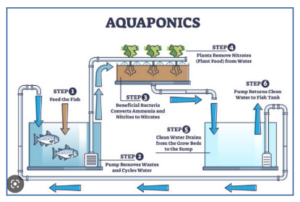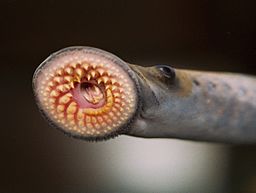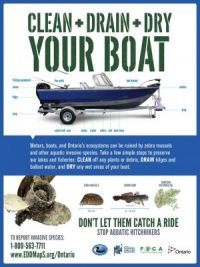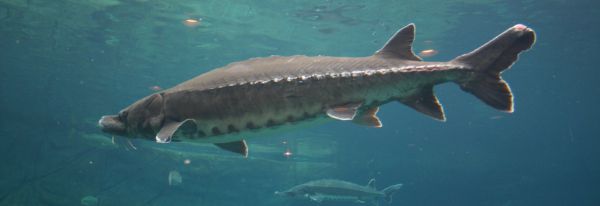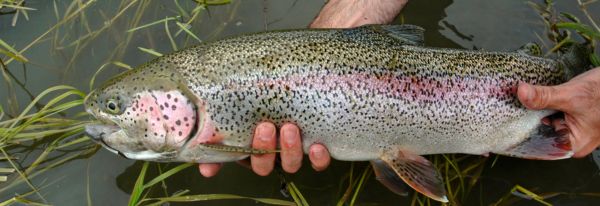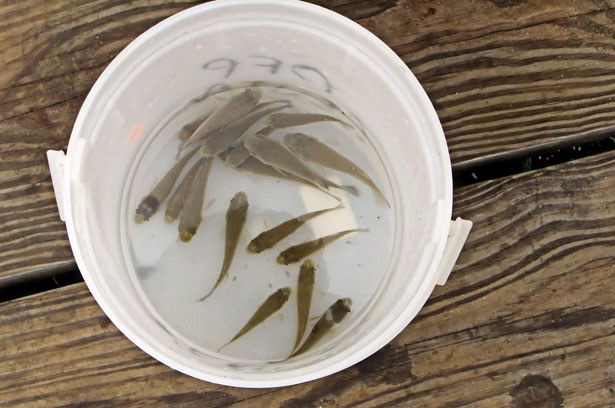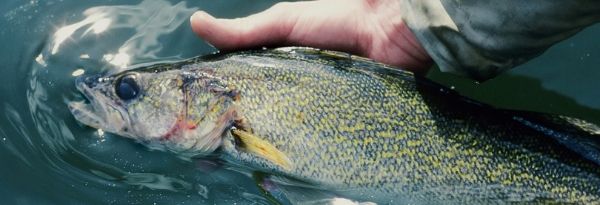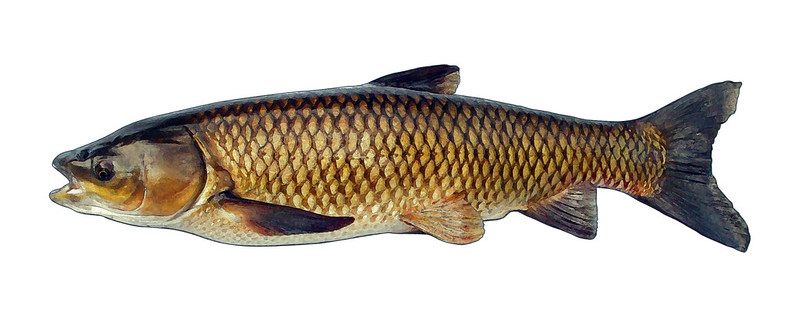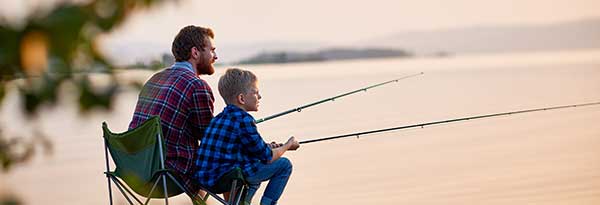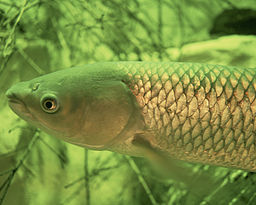What is Aquaculture
Aquaculture is the farming of fish, seafood and other aquatic organisms in water (fresh or saltwater). This farming can occur either in open bodies of water or in land-based facilities. Open-net aquaculture facilities incorporating net pens or open cages occur within a water body, either off the coast or in a freshwater lake and allows for the exchange between the farm and surrounding aquatic environment. Land-based aquaculture consists of farming in regulated tanks within a facility using either a flow-through or recirculating water supply.
Aquaculture has been identified as an important industry to help support increased global food demand and protein sources. But like any industry there are cons with the pros. Two overarching topics of concerns GBA’s aquaculture committee has identified are:
- The environmental impacts of open-net aquaculture in freshwater
- Inconsistent regulations across Canada and provincial government jurisdictions
GBA understands the importance of aquaculture to help to address global demand without impacting wild fish stocks. However, we believe that open-cage aquaculture in the Great Lakes (including Georgian Bay and the North Channel) is not a sustainable industry and the current operations (and all future operations) should be moved to land-based, contained, sustainable facilities.

The Situation in Georgian Bay
 There are currently five commercial open-cage aquaculture operations and six Indigenous operations in Georgian Bay & the North Channel which use a public resource – the fresh water of Lake Huron – for industrial fish farming and waste disposal. The potential negative environmental impacts from this misuse of a public resource is one of the main concerns that GBA has with open-cage aquaculture. Read more about the environmental concerns below.
There are currently five commercial open-cage aquaculture operations and six Indigenous operations in Georgian Bay & the North Channel which use a public resource – the fresh water of Lake Huron – for industrial fish farming and waste disposal. The potential negative environmental impacts from this misuse of a public resource is one of the main concerns that GBA has with open-cage aquaculture. Read more about the environmental concerns below.
Cole Munro now owns all the five commercial operations and manages two of the indigenous operations, see the site locations below. The majority of fish grown in Georgian Bay are Rainbow Trout.
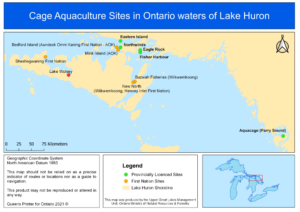
Although open-cage aquaculture is allowed in Georgian Bay, it is not supported or endorsed by the eight US Great Lakes (GL) states and is not permitted in Quebec. It conflicts with the principle that underpin the Great Lakes Water Quality Agreement (GLWQA), and several objectives of the GLWQA annexes. It is a matter of profit for the industry (that only Ontario supports) vs. guardianship of the Great Lakes waters for future generations
The Aquaculture Committee Mandate
- To investigate and advise the GBA Board and develop strategies to address issues resulting from open net pen aquaculture operations in Georgian Bay and the North Channel (“Aquaculture”).
- Act as liaison with the Georgian Bay Mnidoo Gamii Biosphere, Georgian Bay Forever, and any other relevant organizations with regard to Aquaculture issues.
Action taken by GBA
The Aquaculture committee was established in 1997 and has worked on several initiatives to help ensure that there are strong regulations and environmental safeguards in place for open-cage aquaculture and water quality to protect the pristine waters of Georgian Bay. Currently, the main priorities for the GBA aquaculture committee are to:
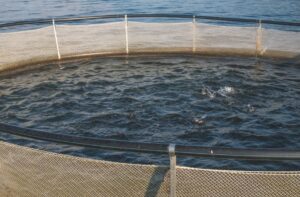 Ensure that the licensing conditions for the proposed new 20 year licenses (to replace the current 5-year licenses) contain robust and improved environmental safeguards;
Ensure that the licensing conditions for the proposed new 20 year licenses (to replace the current 5-year licenses) contain robust and improved environmental safeguards;- Ensure the government regulators give notice on the Environmental Registry a minimum every 5 years of compliance to water quality and sediment health, escapement incidences and numbers, disease outbreaks and antibiotic use, and change in species farmed at each cage site.
- Oppose any expansion of the industry from the current limits of June 6, 2024, whether expansion of operational zones, increased feed quotas for existing operations, or new sites;
- Continue to push for more scientific research (see here);
- Continue to push for the industry to be moved on land; and
- Continue to inform and educate GBA members and the public about the environmental risks, lack of social license and actual harm caused by this industry over the years.
Read more of the current and past initiatives taken by the GBA Aquaculture Committee here.
Environmental Impact
There are several environmental impacts that are related to the open cage aquaculture and the following four topics are the key ones identified by the GBA aquaculture committee
- Nutrient Loading
- Sedimentation
- Impacts on native species
- Chemotherapeutants
The Aquaculture Committee has prepared a comprehensive literature review “Environmental Effects of Open-Cage Salmonid Aquaculture in Ontario: A Review and Recommendations for Future Research“ which is an excellent resource that details the scientific background underlying these four concerns. The purpose of this review is to provide information to all Georgian Bay and North Channel residents about the environmental issues related to regional open-cage aquaculture, and to identify data gaps in our
understanding of these issues as they relate specifically to Georgian Bay waters and where research is
needed.
| Nutrient loading, particularly of nitrogen and phosphorus compounds, is a common environmental concern for bodies of water and has been widely studied in both freshwater and marine systems. One of the main concerns of nutrient loading is how it changes the water quality and impacts the ecosystem. With excess nutrients there can be excess primary productivity (algae and plant matter growth) that actually causes the body of water to become more eutrophic. When this occurs there can be a change of light conditions and changes in dissolved oxygen and pH; these are changes that can lead to fish kills. |
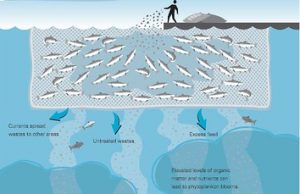
2. Sedimentation
|
Sediments (mainly from fish faeces) falling under the open-cages accumulate can become a reservoir for nutrients. Nutrients, such as phosphorus (P), can be recycled back into the water column, which can impact water quality. Having excess sources of nutrients can lead to increased primary productivity and eventually eutrophication. |
3. Impacts on Native Species
|
The impacts on native species within Georgian Bay have not been widely studied but the potential concerns on native species are escapees competing for resources (food and habitat) with native fishes, and being vectors for disease pathogens. |
4. Chemotherapeutants
|
There is concern regarding the possible effects of chemotherapeutants, such as antibiotics used and/or other contaminants, being released into the environment from medicated feed or other treatments. |
These environmental concerns are not isolated from one another and can have cumulative effects on the
ecosystem, coupled with other issues outside of open-cage aquaculture farming. GBA’s stance is that there are too many potential un-researched impacts regarding open-cage aquaculture to allow for the continuation and addition of open-cage farms. GBA also is advocating for independent and government funded research projects on the topics above and additional projects that are highlighted in the “Environmental Effects of Open-Cage Salmonid Aquaculture in Ontario: A Review and Recommendations for Future Research“.
Governing Bodies
In Canada, aquaculture is governed both federally and provincially. In Ontario:
- The Ministry of Natural Resources (MNR) is the regulatory body for this industry.
- The Ministry of Environment, Conservation and Parks (MECP) oversees environmental impact issues.
- Environment and Climate Change Canada (ECCC) and Fisheries and Oceans Canada (DFO) – which has responsibility for Canada’s fresh and marine waters – are at arm’s length from regulating, having handed over regulatory powers and policy initiatives to MNR (and MECP). DFO does provide some funding for science.
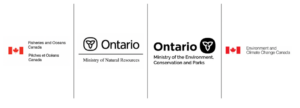
Land-based Aquaculture
 GBA supports land-based aquaculture farms and is advocating for all current open-cage operations to move to land-based operations. The following are a few key elements that make land-based aquaculture operations more beneficial than open-cage aquaculture:
GBA supports land-based aquaculture farms and is advocating for all current open-cage operations to move to land-based operations. The following are a few key elements that make land-based aquaculture operations more beneficial than open-cage aquaculture:
- Land-based operations do not use the public aquatic resource of Georgian Bay as production space for rearing fish nor as a waste treatment and dilution system.
- There are reduced environmental impacts on water quality and native fish populations since waste effluent can be properly managed and controlled before reaching receiving waters.
- Recirculating Aquaculture Systems are becoming more technically and economically advanced. With clean, fresh water and healthy fish to start with, they can be certified organic – no use of antibiotics because there will be no disease outbreak if reared with Best Aquaculture Practices for the fish health.
